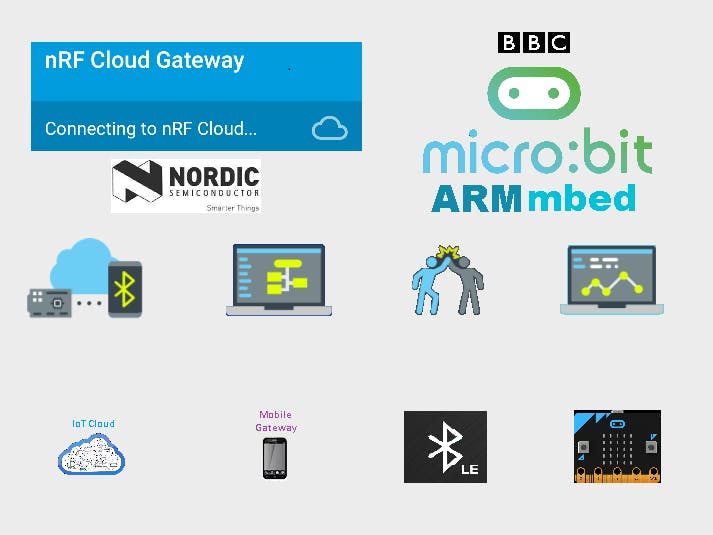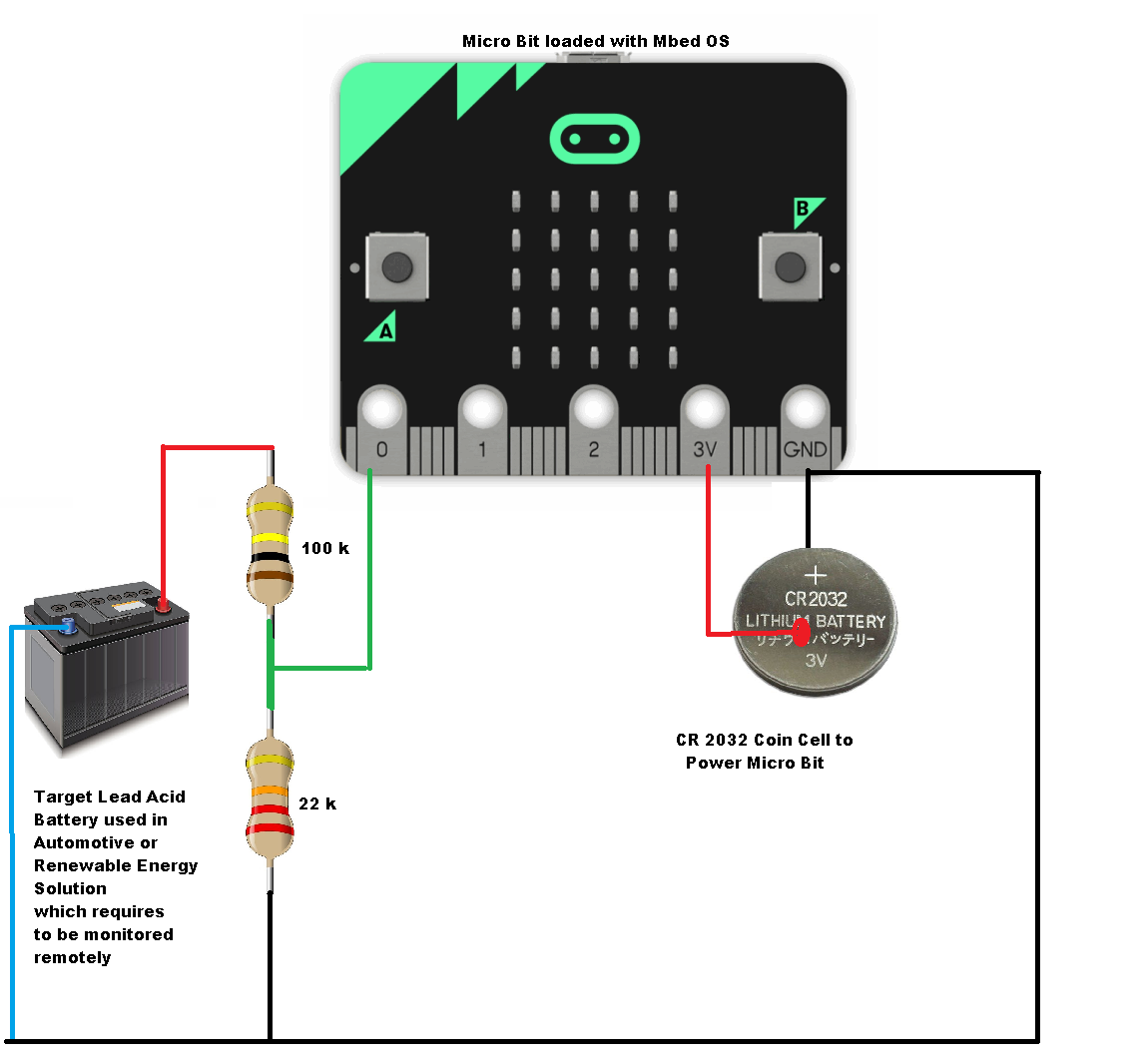BBC micro:bit is essentially an nRF51822 development board with lots of goodies. It has BLE (Bluetooth Low Energy ) feature which enables IoT capabilities. Although the board is mainly focused for kids to learn programming on GUI Block Editor environment, professional developers and hardcore hobbyists can program this board on Mbed platform as an nRF development board to utilize the free development apps/services from Nordic Semiconductor. There are program examples on Mbed too. In this project, an UART-BLE based IoT solution for BBC micro:bit will be developed utilizing these services.
Connection TopologyFollowing diagram explains the connectivity of Micro:bit to the Internet.
- Micro:bit sends UART data over BLE to an Android device running Gateway App. This app ports data over Wifi/LTE network to the Internet.
- Then the data goes to the nRF IoT Cloud service.
- From the other side user can access the Cloud to fetch data through appropriate credentials. The same credentials (login ID/password ) must be applied to the Gageway App.
- Gateway app acts as a bridge since BLE devices can't directly access internet.
Go to https://os.mbed.com/account/signup and create a free account or login with existing account.
Go to https://nrfcloud.com and create an account.
A 4x6 cm Protoboard is soldered with the micro:bit to pin out the I/O pins. This protoboad will protect the chips on the board and allow space for additional circuits.
For this project, a lead acid battery which is used in an existing automotive or renewable energy solution will be monitored remotely. That is why a 22k+100K voltage divider network is soldered on a protoboard on the back of the micro:bit.
The CR2032 holder will allow portable power option. 2 N-Ch MOSFETs are also installed for Load control.
Finally, the Lead Acid battery is connected to the microbit to monitor its voltage remotely.
Login to mbed account and go to https://os.mbed.com/platforms/ to select BBC Micro:bit as platform.
Go to following link and Import to Mbed Compiler
If everything is done properly, Mbed should appear like this on web browser :-
- Board Setting : BBC micro:bit (default)
- Click "Compile" to compile the code and generate hex file
Warning : Do not update "BLE_API" and "NRF51822" folders
Code Tips 1 :
ticker.attach(periodicCallback, 5);
Ticker is a thing in MBED that calls a function periodically, here it will call "periodicCallback" every 5 seconds, which means data will be send every 5 seconds to the cloud. If you wish to send data every 1 minute or 60 seconds
write this line :
ticker.attach(periodicCallback, 60);
Code Tips 2:
while (true) {
ble.waitForEvent();
val = ain.read_u16();
/// bla bla your code
}
Inside the while(true) {} loop with in int main(void){} is the place to write your program code.
Following BLE API must be kept running for BLE to work continuously.
ble.waitForEvent();
The following code fetch ADC data and keep it on val variable.
val = ain.read_u16();
Code Tips 3:
The blePrintf() API sends UART data over BLE. It only accepts String or char array. Therefore, before sending Numerical value, it must be converted to String
void periodicCallback(void)
{
blePrintf("BATT VOlT: ");
blePrintf(result);
blePrintf("\r\n");
}
See details here: https://os.mbed.com/docs/latest/reference/drivers.html
Writing a DigitalPin :
#include "mbed.h"
DigitalOut pin1 (P0_2); // big hole 1
int main()
{ while(1)
{ pin1 = 1; //same as digitalWrite (D7, HIGH);
wait (0.5); //same as delay(500)
pin1 = 0; //same as digitalWrite (D7, LOW);
wait (0.5); //same as delay(500);
}
}
Reading a Digital Pin :
#include "mbed.h"
DigitalIn buttonA (P0_17); // On Board Push Switch A
int main()
{
int sw_state = 0;
while(1)
{ sw_state = buttonA.read(); // same as x = digotalRead(3)
if (sw_state)
{
// do something
}
else
{
// do something else
}
}
}
Connect micro:bit to PC with an USB cable and copy the hex file to micro:bit.
- Go to Google Play store and Install nRF Gateway app.
- Turn on Bluetooth on the android device and run the app
- Login with previously created ID and Password for nRF cloud account.
- Keep the micro:bit nearby (with in 10 meters)
To establish the connection login from both the app and the remote terminal is required. This way both sides are connected to the cloud and exchange data.
Following videos demonstrate the connection and data exchange : -
App LinksCode References- stackoverflow.com/questions/23191203/convert-float-to-string-without-sprintf/23191607#23191607
- https://os.mbed.com/teams/Bluetooth-Low-Energy/code/BLE_URIBeacon/?platform=Nordic-nRF51-DK
- https://os.mbed.com/teams/Bluetooth-Low-Energy/wiki/UART-access-over-BLE
- https://os.mbed.com/users/suntopbd/code/uBit_BLE_UART_Voltmeter_IoT
- https://docs.mbed.com/docs/ble-intros/en/latest/Introduction/BLE_API/
Go to https://docs.api.nrfcloud.com/ and get an API key for connecting to other web services with Micro:bit.
Additional Notes- nRF Cloud is free for developers but the message limit is 1 Million per account
- Android device must have BLE (Bluetooth 4+)
- Micro:bit Mbed library is compatible with nRF51822 Mbed library which means 5x5 matrix display, accelerometer, magnetometer, etc. might work directly with associated API and device libraries (workaround required)
- Pin mapping as follows: (second column alias to be used in Mbed)
///////////////// pin table /////////////////////////
/////////////////////////////////////////////////////
// edge.pin nrf51822pin functions note //
/////////////////////////////////////////////////////
// P2 P0_1 ADC/PWM/DIO 2 //
// P1 P0_2 ADC/PWM/DIO 1 //
// P0 P0_3 ADC/PWM/DIO 0 //
// P16 P0_16 DIO //
// P5 P0_17 Button A/DI pullup //
// P11 P0_26 Button B/DI pullup //
// P20 P0_30 I2C SDA/DIO pullup //
// P19 P0_0 I2C SCL/DIO pullup //
// P15 P0_21 SPI MOS/DIO //
// P14 P0_22 SPI MIS/DIO //
// P13 P0_23 SPI SCK/DIO //
/////////////////////////////////////////////////////
// LED Matrix pins //
// ROW 1 P0_13 ROW 2 P0_14 ROW 3 P0_15 //
// COL 1 P0_4 COL 2 P0_5 COL 3 P0_6 //
// COL 4 P0_7 COL 5 P0_8 COL 3 P0_9 //
// COL 7 P0_10 COL 8 P0_11 COL 9 P0_12 //
/////////////////////////////////////////////////////
/////////// See uBit to nrf51822 Schematic for detailed pinout //////////////////////
// https://github.com/bbcmicrobit/hardware/blob/master/SCH_BBC-Microbit_V1.3B.pdf //
/////////////////////////////////////////////////////////////////////////////////////
If you need to use all the available pins check this schematic of Microbit for other pins aliases to nRF51822.
source: uBit Schematic





















Comments
Please log in or sign up to comment.